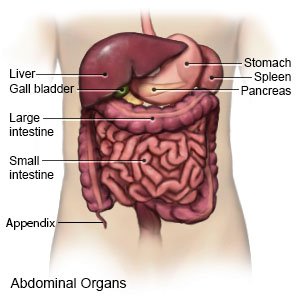Pyloric Stenosis
Medically reviewed by Drugs.com. Last updated on Aug 4, 2025.
Pyloric stenosis is a condition that causes narrowing of the pylorus. The pylorus is the muscular opening at the lower end of the stomach that connects to the intestines. Narrowing prevents food from moving from the stomach to the intestines. The cause is not known.
 |
WHILE YOU ARE HERE:
Informed consent
is a legal document that explains the tests, treatments, or procedures that your child may need. Informed consent means you understand what will be done and can make decisions about what you want. You give your permission when you sign the consent form. You can have someone sign this form for you if you are not able to sign it. You have the right to understand your child's medical care in words you know. Before you sign the consent form, understand the risks and benefits of what will be done to your child. Make sure all of your questions are answered.
Stay with your child for comfort and support
as often as possible while he or she is in the hospital. Ask another family member or someone close to the family to stay with your child when you cannot be there. Bring items from home that will comfort your child, such as a favorite blanket or toy.
IV:
An IV is a small tube placed in your baby's vein that is used to give him or her medicine or liquids.
Intake and output:
Healthcare providers will need to keep track of what your baby drinks and urinates. They will weigh your baby's diapers. Do not throw away diapers without letting someone know.
Tests:
- Blood or urine tests will show dehydration and other problems caused by pyloric stenosis.
- An ultrasound uses sound waves to show the narrowed pylorus and fluid movement into the intestines.
- Upper GI x-rays may show how fluid flows from the stomach into the intestines. The upper GI includes the esophagus, stomach, and intestines. Your baby may drink barium (chalky contrast agent) to help his or her organs show up clearly.
Treatment:
- Hydration is used to put fluids, sugar, and salts into your baby's body through an IV.
- A nasogastric (NG) tube is used to give food and medicine. Your baby may need an NG tube if he or she cannot feed normally. The NG tube will be put into your baby's nose and guided down his or her throat to the stomach. The tube may be attached to suction if your baby's stomach needs to stay empty.
- Surgery may be needed to cut and loosen the pylorus to allow food to pass through.
RISKS:
Your baby may become dehydrated. His or her risk for an infection is increased. A severe decrease in fluids, sugar, and salts may cause seizures and a coma.
CARE AGREEMENT:
You have the right to help plan your baby's care. Learn about your baby's health condition and how it may be treated. Discuss treatment options with your baby's healthcare providers to decide what care you want for your baby.© Copyright Merative 2025 Information is for End User's use only and may not be sold, redistributed or otherwise used for commercial purposes.
The above information is an educational aid only. It is not intended as medical advice for individual conditions or treatments. Talk to your doctor, nurse or pharmacist before following any medical regimen to see if it is safe and effective for you.
Learn more about Pyloric Stenosis
Treatment options
Care guides
Further information
Always consult your healthcare provider to ensure the information displayed on this page applies to your personal circumstances.
